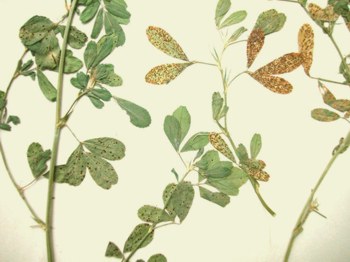Diseases
Pseudopeziza medicaginis (Lib.) Sacc. - Common, or Pseudopeziza Alfalfa Leaf Spot
Systematic position.
Class Ascomycetes, order Leotiales, family Dermateacea, genus Pseudopeziza.Biological group.
This species is a biotroph.Morphology and biology.
P. medicagini is a specialized parasite infecting Lucerne only. Small, circular, dark brown to black spots, to 3 mm in diameter develop first on leaves, leafstalks, stems, or developing pods. The spots never merge. A tiny light-brown disk-shaped fungal fruiting body forms in thickened center of completely developed spots on the upper leaf surface. The fungus is known only in ascostages; reports on conidial stages (Phoma medicaginis) are doubtful. Central apothecium is about 350 microns in diameter and daughter apothecia located around it are 180 microns in diameter. Ascus is 70 x 10 microns, clavate, usually containing 8 ascospores. Paraphyses are threadlike, colorless, expanded at ends, to 75 microns long. Ascospores are oviform or elliptical, straight or weakly bent and colorless, unicellular, 10 x 5 microns. Large amounts of spores drift into the air during cool to warm wet weather, being carried by wind flow and rain splash to other plants. Thus, the disease can spread quickly throughout a field. The causal fungus over-winters as apothecia in fallen, un-decayed leaves and leaf fragments on soil surface. It is not known to be seed borne. In spring the apothecia ripen and form ascospores becoming the source of initial infection.Distribution.
The disease is common among alfalfa cultivation areas in different countries of Europe, Asia, Africa, America, and Australia. In the territory of the former USSR it is found in all regions of alfalfa cultivation except for Northwestern and Central European regions.Ecology.
The maximum disease intensity is observed during rather warm and damp weather. Ascospores begin to germinate at temperatures 7-14.C and relative air humidity 97-100%. Optimum temperature for spore germination is 20.C. Rains, dews, ascending air streams promote formation of spores and disease spreading. The disease incidence and intensity decrease during dry warm summer.Economic significance.
Although plants are not destroyed by the disease, defoliation causes loss of vigor and reduces hay yield and its quality. The disease development and its harm increase with age of crops. The disease can cause abscission of 35% leaves that results in hay weight decrease by 15%. Besides this, hay nutritious quality decreases; amount of protein is reduced by 10%. The yield of seeds can be reduced by 60%; the sowing quality of seeds in the infected beans is reduced. Control measures include: removal of residues in spring, cultivation of alfalfa in mixtures with other leguminous or cereal grasses, cultivation of resistant varieties, harvest of the highly diseased crops even before the optimal harvest time. Fertilization (especially with potassium) and good management practices can also help to reduce losses. In seed fields treatments by foliar fungicides are possible.Reference citations:
Ainsworth G.C., ed. 1971. Ainsworth and Bisby's Dictionary of the fungi. 6 ed. Kew, Surrey: CAB Intern. 663 p.Hawksworth D.L., Kirk P.M., Sutton B.C., Pegler D.M. 1995. Ainsworth & Bisby.s Dictionary of the fungi. Kew: CAB International. 616 p.
Karavyanskii N.S., Mazur O.P. 1984. Complex system. Zashchita rastenii 10: 24-26. (In Russian)
Salunskaya N.I. 1969. Diseases and pests of grasses (trefoil and alfalfa) and measures of their control. Moscow. 67-94 p. (In Russian)
Tarkovskii M.I. 1974. Lucerne. Moscow: Kolos. 240 p. (In Russian)
Tyunin V.A. 1972. Common spot of alfalfa and agronomical measures limiting its harm in Trans-Ural region. PhD thesis. Yerevan. 21 p. (In Russian)
Tyunin V.A., Lopatin M.I. 1970. To question on diagnostics and etiology of alfalfa anthracnose. Protection of agricultural crops against pests and diseases. Kurgan: Kurgan Agricultural Institute. Issue 21. 63-69 p. (In Russian)
© Dmitriev A.P.


